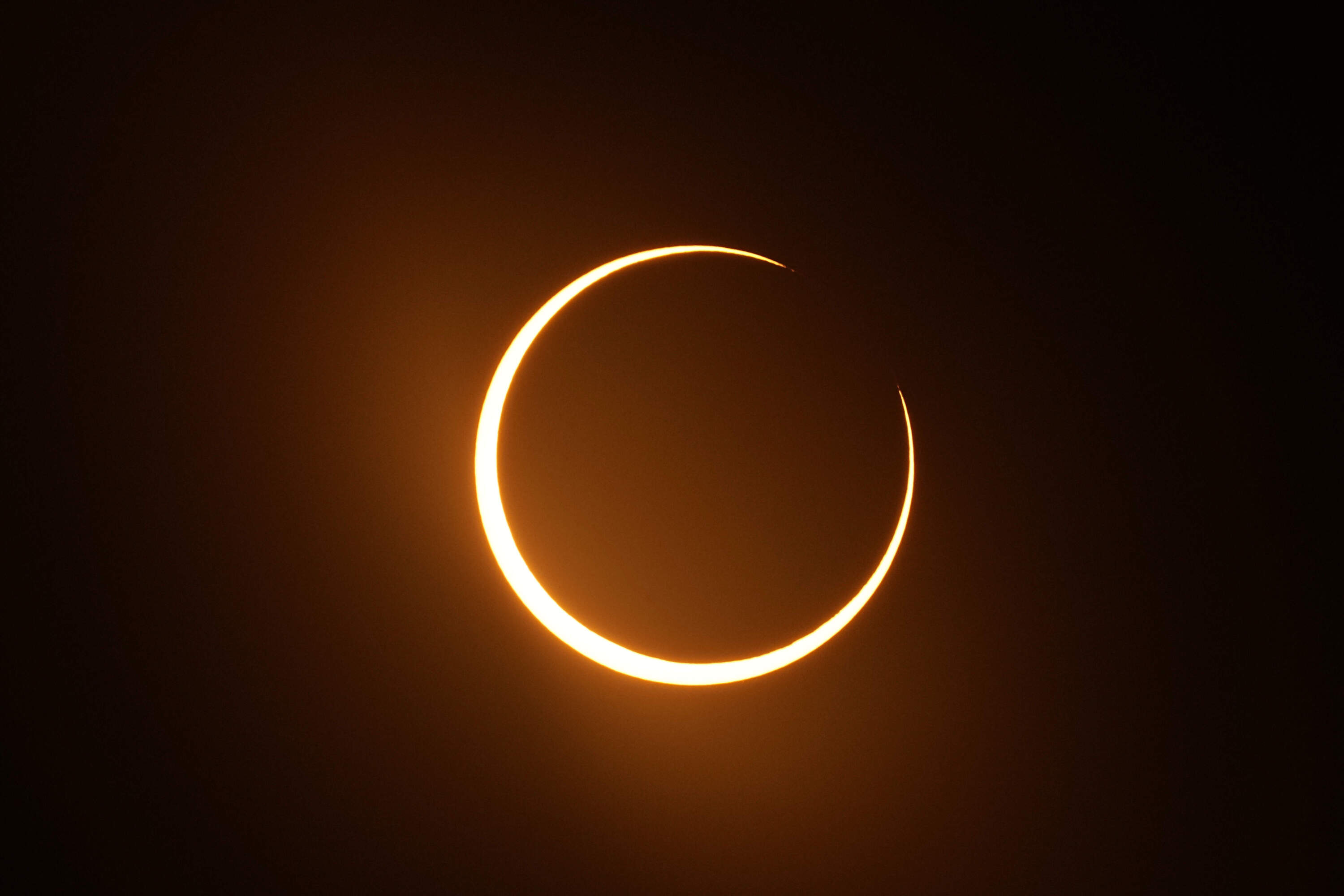


After the recent partial lunar eclipse, astronomy enthusiasts are in for another treat - a rare annular solar eclipse, also known as the "ring of fire" eclipse. This astronomical event will take place on October 2 as India commemorates Mahatma Gandhi's birth anniversary. The eclipse will be visible over southern Chile and Argentina, with the Moon appearing smaller than the Sun and creating a distinctive "ring of fire" effect in the sky.
Solar Eclipse of October 2, 2024: The "Ring of Fire" Spetacle
A celestial spectacle awaits skywatchers on October 2, 2024, as a fascinating annular solar eclipse known as the "ring of fire" graces the heavens. During this astronomical event, the Moon will pass directly between the Earth and the Sun, but its size will be smaller than the Sun, allowing the Sun's corona to peek out around the edges, creating a mesmerizing ring of light.
Background on Solar Eclipses
Solar eclipses occur when the Moon aligns itself between the Earth and the Sun, blocking the Sun's light. There are two main types of solar eclipses:
October 2, 2024 Annular Solar Eclipse
The annular solar eclipse of October 2, 2024, will be visible from a narrow path stretching across southern Chile and Argentina. Observers within this path will be treated to a breathtaking sight as the Moon covers the central portion of the Sun, revealing the Sun's corona as a brilliant ring.
The eclipse will begin at sunrise in Chile, and the "ring of fire" phase will be visible for about 2 minutes and 20 seconds. As the eclipse progresses, the Moon will gradually move across the Sun, and the path of visibility will shift to Argentina. The total duration of the eclipse, from the beginning to the end, will be approximately 3 hours.
Top 5 FAQs about Solar Eclipses
1. Are solar eclipses dangerous to look at?
Yes, looking directly at a solar eclipse without proper eye protection can cause severe and irreversible damage to the retinas. Use eclipse glasses, solar filters, or indirect projection methods to view the eclipse safely.
2. How often do solar eclipses occur?
Solar eclipses are relatively common events, but total and annular solar eclipses are less frequent. On average, there are about 2-3 solar eclipses per year, but only a fraction of them are visible from any given location.
3. What are the effects of solar eclipses on wildlife?
Solar eclipses can have significant effects on wildlife. Birds may become temporarily disoriented during total eclipses due to the sudden darkness. Animals that are active during the day may also experience confusion and disruption in their sleep-wake cycles.
4. Why do annular solar eclipses happen?
Annular solar eclipses occur when the Moon is at its farthest point from the Earth in its orbit. At this distance, the Moon appears smaller than the Sun, resulting in the ring of fire effect.
5. What are some notable historical solar eclipses?

As winter arrives in India, so does the hazardous air pollution. Delhi NCR's AQI has already crossed the 400 mark, making it crucial to invest in air purifiers, especially after Diwali. Dyson, Qubo, HomePure, and Philips have launched high-quality air purifiers with advanced features to tackle different types of pollutants and create cleaner indoor air. With prices ranging from Rs 5,000 to Rs 1 lakh, these purifiers are a practical and timely purchase for a healthier living.

In a recent family vlog, Indian celebrity couple Shoaib Ibrahim and Dipika Kakar shared their "natural" hair care routine for their son, using a homemade mask made with rice flour, flax seeds, and coconut oil. However, experts warn that what works for adults may not be suitable for babies, whose sensitive skin and scalp could react to the ingredients. While the ingredients may improve hair texture, they do not necessarily promote hair growth. Instead, a healthy diet and good scalp care are more important in maintaining healthy hair.

A recent consumer study has found multiple brands of soft contact lenses in the U.S. to contain "forever chemicals" that can be harmful to both the body and the environment. The study, conducted by the nonprofit organization Environmental Health Sciences, tested 18 varieties of popular contact lenses and found all of them to contain markers for PFAS. Brands such as Acuvue, Alcon, and CooperVision were among the list of affected products. This news serves as a cautionary lesson on the potential risks of overusing contact lenses.

On the birth anniversary of Dr. APJ Abdul Kalam, the ‘Missile Man’ of India, tributes pour in on social media celebrating his life, vision and impact. A visionary scientist, inspiring leader and true patriot, Dr. Kalam's humility, compassion and constant interaction with students continue to inspire generations. His tireless efforts in defense, science and youth empowerment have strengthened India's path towards self-reliance and his legacy continues to motivate young minds to dream big and work hard for the nation.

Recent studies have found that extreme heat, particularly when combined with high humidity, can have a significant impact on mental health. A study in India showed that when wet bulb temperature exceeded 27°C, the probability of reporting severe depression increased by 0.5%, even when the temperature was slightly lower. This finding is consistent with global reviews that have linked high temperatures to mood disorders, increased hospital admissions for psychiatric conditions, and even elevated suicide risk. The Lancet has also published evidence that rising temperatures worldwide are a growing threat to emotional and cognitive health.

In a meeting with university officials in Udaipur, Rajasthan Governor Hari Bhau Bagde stressed the importance of incorporating India's ancient knowledge traditions into academic research. He highlighted the deep repository of knowledge in India since ancient times and urged scholars and scientists to draw upon this tradition in their work. Bagde also suggested making ancient texts available in university libraries for study and research purposes, in order to shape the intellectual abilities and love for the nation among the younger generation.

John Clarke, Michel H. Devoret, and John M. Martinis have been awarded the 2025 Nobel Prize in Physics for their pioneering research into quantum mechanical tunnelling. Their discovery has opened new possibilities for quantum technologies, and will be formally presented on December 10, the anniversary of Alfred Nobel's death. This announcement follows the tradition of recognizing transformative contributions to science, and the award carries a prestigious prize of 11 million Swedish kronor.

The US-Japanese trio of Mary E Brunkow, Fred Ramsdell, and Shimon Sakaguchi have won the 2025 Nobel Prize in physiology or medicine “for their discoveries concerning peripheral immune tolerance". Through their research, they have shown how the immune system is kept in check and why serious autoimmune diseases do not affect everyone. Sakaguchi found a new class of T cells, while Brunkow and Ramsdell discovered the explanation behind a specific mouse strain's vulnerability to autoimmune diseases. Together, they have significantly advanced our understanding of immunology and autoimmune diseases.

Indian astronaut Shubhanshu Shukla, who recently completed a 20-day space mission, shared his insights and experiences at the convocation ceremony of Dr. APJ Abdul Kalam Technical University. He highlighted the importance of patience, focus, and the inevitability of change in achieving success, and urged the graduating class to actively contribute to shaping a fearless and ambitious India.

The Regional Meteorological Centre (RMC) in Chennai has issued a weather alert for parts of Tamil Nadu, with thunderstorms and light to moderate rainfall expected on Saturday. The alert was issued due to the strengthening of a cyclonic circulation in the Bay of Bengal, which is likely to intensify and form a low-pressure area. The system is expected to affect Tamil Nadu, Puducherry, and Karaikal, with some areas experiencing heavy rainfall and gusty winds. The public is advised to stay updated and take precautions, especially in hilly and western districts.